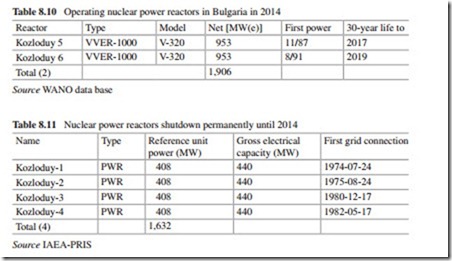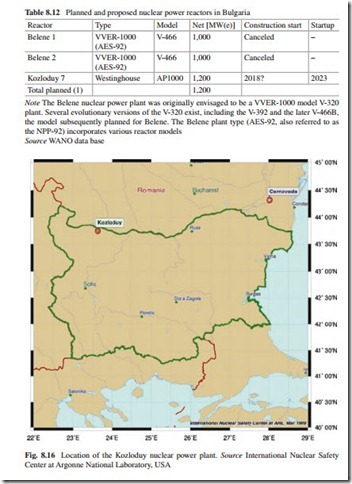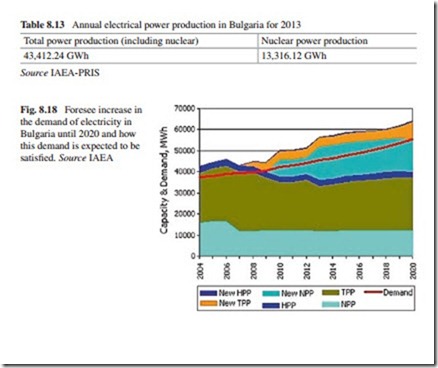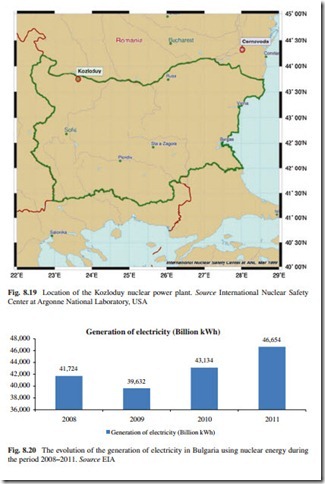Bulgaria
Bulgaria has very few domestic energy resources that can be used for the generation of electricity and, for this reason, since 1956 the government has favored the use of nuclear energy for this purpose. Proven oil and gas reserves in the country have declined for a number of years and are not enough to satisfy the foreseeable energy demand. Hydropower potential is also limited since most of Bulgaria’s rivers are small and the only large river, the Danube, has a small drop in altitude where it forms a Bulgaria’s Northern border with Romania.
It is important to highlight that electricity consumption in Bulgaria has grown slowly since 1980, given the country the possibility to be an exporter of power to other countries. In 2005, Bulgaria’s National Electricity Company (NEK) pro- duced 44 billion kWh and exported 7 billion of kWh to Greece, Turkey, Serbia, and Macedonia. In 2011, the country produced 46.654 billion kWh, an increase of 6 % with respect to 2005 and exported 9.532 billion kWh, an increase of 36.2 % with respect to 2005. The peak in the export of electricity in the past years was reached in 2011 with 12.110 billion kWh.
The energy sector is an important section of the Bulgarian industry. Its structure and development are based predominantly on imported energy sources and the used of domestic low-quality lignite coal. Despite of its limited indigenous energy resources, the energy sector is well balanced. The electricity production in the country is based on the use of:
• Solid fuel;
• Nuclear power;
• Natural gas;
• Hydro resources;
• Renewables.
The share of the imported energy resources referred to the general import of raw materials, other materials, investment, and consumer goods is about 18 %. From these imported energy resources only 35.4 % is used in the energy sector for the production of electricity and heat power. The nuclear share is 37.6 % of the imported energy resources.
Bulgaria has two nuclear power reactors in operation (see Table 8.10), Kozloduy 1 and 2, with a power net capacity of 1,906 MWe, producing 30.67 % of the total electricity generated in the country in 2013, a decrease of around 2.25 % with respect to the participation reached in 2008. The country has four nuclear power reactors permanently shutdown (see Table 8.11).
The government has plans to construct at least one nuclear power reactor in 2018, but this is an indicative year. This new nuclear power reactor is going to be built on the Kozlouduy nuclear power site (see Table 8.12; Figs. 8.16 and 8.17).
The Energy Policy and the National Energy Strategy
According to Morales Pedraza (2012), after the collapse of the Soviet Union, the Bulgarian’s government adopted a new energy policy and strategy in order to increase the efficiency of its energy sector with the purpose of satisfying the fore- seeable increase in the demand of electricity. This new energy policy was adopted bearing in mind the new political and economic situation of the country and the plans to become a member of the EU in the future.
The energy strategy of Bulgaria is based on the national priorities and corre- sponds to the new lasting positive political and economic trends in the country, as well as to the requirements of the European guidelines, the principles of market
mechanisms, and the government’s program. It is determined by the requirements for ensuring sustainable economic growth and raising the living standard of the Bulgarian population. The strategy has been developed in conformity with the natural and geographic factors determining the inherent role of the country in the region, and the optimal mix of energy resources used in accordance with the specific conditions. According to IAEA sources, the main objectives guiding the energy development are given as follows:
• Through competitive energy to competitive economy;
• Continuous and safe coverage of the national energy needs with minimum public cost;
• Providing energy independence for the country;
• Reduction in specific energy intensity per GDP unit in economy;
• Ecologically oriented development;
• Establishment of competitive internal energy market;
• Integration of the Bulgarian energy system and energy market with the one adopted by the EU;
• Maintaining the nuclear safety at an acceptable level;
• Utilization of local renewable energy sources.
However, the establishment of an up-to-date and market-oriented energy sector can- not be achieved only with the adoption of the above objectives. It is important to take into account a series of prerequisites that have been missing up to this date, namely:
• Normalization of energy prices in line with the justified full economic costs and phasing out of the subsidies for generators;
• Financial recovering and establishment of energy companies operating on a
commercial basis;
• Proper functioning of regulatory authorities and mechanisms;
• Market rules and structures;
• Appropriate legal framework.
Concurrent actions should be undertaken, mainly in the following areas:
• Establishment of financially viable commercialized companies;
• Institutional changes;
• Enhancement of the role, autonomy, and influence of the regulatory body (SERC);
• Transition from administration to regulation and introduction of clear regulatory rules for the market players;
• Deregulation;
• Introduction of clear and sustainable market rules and a clear schedule for the opening of the internal and external market to competition, including delegation to SERC of the powers to enforce market rules;
• Legal changes;
• Discussion and adoption of a new energy law, which would ensure a legal framework for the successful implementation of the above areas of the reform;
• Transfer of ownership aiming to attract investments and to bring the management practice in line with up-to-date standards.
At the same time, it is important that the government adopts a set of principles based on which its energy policy should rest. The following are those principles:
• The introduction of market relations, based on cost-reflective tariffs and free contracting;
• The active role of the state in the creation of a clear and stable legal and regulatory framework for investments, commercial activity, and protection of public interests;
• Creation of a legal, regulatory and market environment prior to the implementation of new large-scale investment and privatization projects;
• Proactive energy efficiency policy as a means for improving the competitiveness of the economy, security of energy supply, and environmental protection;
• Efficient social protection through shifting government subsidies from the producer to the consumer, through energy efficiency measures and introduction of socially oriented tariffs;
• Positioning of Bulgaria as a reliable country for the provision of future transit of oil,
natural gas, and electric power and as a dispatching and market center in the region.
In the future, the Bulgarian’s government energy policy will rely on the following two main energy sources: (a) Nuclear energy; and (b) Local lignite coal.
Electricity Generation Using Nuclear Energy
The total electricity generated in the country and the participation of nuclear energy in the energy mix of Bulgaria are shown in Table 8.13. According to this table, the electricity generated in the country using nuclear energy in 2013 represents 30.67 % of the total.
The foreseeable increase in the demand of electricity until 2020 and how this demand is expected to be satisfied by the different energy source available in the country are shown in Fig. 8.18.
According to Fig. 8.18, the new demand of electricity until 2020 is expected to be satisfied by the construction of new nuclear and thermal power plants. The location of the nuclear power plants in Bulgaria is shown in Fig. 8.19.
The evolution of the generation of electricity in Bulgaria using nuclear energy during the period 2008–2011 is shown in Fig. 8.20.
According to Fig. 8.20, the generation of electricity using nuclear energy increased in Bulgaria during the period 2008–2011 a total of 11.4 %. It is expected, according to the plans approved by the government, that the use of nuclear energy will continue increasing during the coming years.
The Public Opinion
According to Morales Pedraza (2012), the Chernobyl nuclear accident turned nuclear safety in a sensitive political issue in Bulgaria. After this accident, pub- lic opinion, now a much more significant factor for policy makers, had turned strongly against the nuclear industry.
A second nuclear power plant was started at Belene, to add six 1,000 MW power reactors by the end of the Tenth Five-Year Plan. But the construction of the Belene nuclear power plant was halted in 1989 by public opposition to the construction of new nuclear power plants in the country and disclosure that both Kozloduy and Belene were located in earthquake-prone regions. Long-term plans for the use of nuclear power for heat generation were also shelved at that time. In the case of the Belene nuclear power plant, project members of the Bulgarian Academy of Science organized a strong protest against the construction of this plant, based on the result of a scientific research study carried out in 1990 concerning the seismogenic nature of the specific area in which the plant is going to be built. During years, the construction of the Belene nuclear power plant was halted. However, and despite the initial opposition to the construction of the Belene nuclear power plant, the Bulgarian government revived plans for building two units at the Belene site in 2004 and awarded a construction contract to the Russian company ATOMSTROYEXPORT, which had put forward a bid in coop- eration with the French/German AREVA NP.
Since then the Bulgarian government has been appealing to French, German, Italian, Swiss, and US banking groups, asking for investing and financial support to carry out the construction of the Belene nuclear power plant without success, due to the constant and persistent protest of the international antinuclear and environmental movements against the construction of the Belene nuclear power plant.
However, in the middle of the 1990s, the public opinion regarding the use of nuclear energy for electricity generation in the country turns out to be more positive. Around 70 % of the people had the opinion that Bulgaria should continue to use nuclear energy for the production of electricity, while only 11 % were against. These recent data con- firmed the outcome of previous studies carried out during 2004 and 2006.
Summing-up can be stated that there is some opposition to the construction of the Belene nuclear power plant not only in the Belene region itself, but also across the borders in Romania and Greece. In these two countries, municipality leaders and civil organizations representing hundreds of thousands of citizens have declared their opposition to the project. Citizens from the F.Y.R. of Macedonia have also accused the Bulgarian’s government to violate the Espoo Convention on Cross-Boundary Impacts of 1997 in force in both countries. However, it is impor- tant to single out that in the latest polls carried out in Bulgaria in 2007, the con- struction of the Belene nuclear power plant was supported by 73 % of the people, while 13 % were against.
In the case of the closure of four nuclear power reactors at the Kozloduy nuclear power plant, it is important to highlight the following. The decision adopted by the Bulgarian’s government to shutdown the nuclear power plant was the reason to a political struggle in Bulgaria. The Bulgarian Socialist Party garnered 518,000 signatures to protest against the decommissioning, and a powerful nuclear engineering lobby has united to put pressure on the government to drop its commitment to the EU to decommission four reactors (Van der Zwaan 2006).
Pro-nuclear groups say that the commitment to close the Kozloduy nuclear power plant was adopted by the Bulgarian government under pressure by the EC during the accession negotiations for the entry of the country in the EU. The closure of four units in Kozloduy nuclear power plant was adopted without considering the improvement in the safety of the nuclear power reactors carried by the Bulgarian authorities in the 1990s, in close cooperation with the IAEA, WANO, and the EU. The design of the nuclear power reactors was one of the main elements that were considered for the closure of the four units. The first safety review was undertaken by the IAEA in 1991. Large-scale renovations of Units 1–4 at Kozloduy were implemented. The work was undertaken in close consultation with the IAEA, WANO, and the EU to improve safety and bring the units closer to international norms. From 1998 to 2002, a more thorough modernization was undertaken in line with IAEA safety criteria to bring the units into conformity with current world safety standards. This was approved by the Bulgarian Nuclear Regulatory Agency, but only fully implemented on Units 3 and 4. An upgrade and modernization program for Units 5 and 6 was extended to 2006, but there is no great concern about the safety of these units, which conform to international standards (Kovan 2005).
Lastly, it is important to highlight that in an opinion poll carried out in February 2004, around 46 % of respondents said that keeping the reactors was more important than joining the EU, while only 30 % took the opposite view. According to the Alpha Research polling agency, 66 % of the plant’s supporters believed preserving it would keep electricity prices low and 53 % felt the nuclear power reactors would ensure Bulgaria remained strong in the international energy market. Some 41 % opposed for- eign experts making any decisions on the country’s national interests (Shkodrova 2004).
Looking Forward
Proposals for the construction of Units 7 and 8 at Kozloduy nuclear power plant date back to the 1980s, when possible sites were reserved. Early in 2010, a joint assessment by Kozloduy owner and IBERDROLA reported that a seventh unit at the site would be viable, using the existing infrastructure. The government had been considering this, and a possible eighth unit, independently of plans for the construction of the Belene nuclear power plant. WESTINGHOUSE and GE had expressed interest in the project, using the AP1000 or a GE nuclear power reactors design, respectively, but in April 2012 the government confirmed that the seventh unit would comprise what was to be Belene 1, an AES-92 plant supplied by ATOMSTROYEXPORT.
In April 2012, the Council of Ministers approved in principle the construction of new capacity at the Kozloduy nuclear power plant. The Minister for Finance announced that “the government decided to open up for investment the project for Unit 7 at the Kozloduy nuclear power plant. It will be built on market principles, that is, without government money or state guarantees.”
A request for proposals in June 2012 elicited responses from AREVA, AREVA/MITSUBISHI, Bulgaria’s Risk Engineering Ltd, WESTINGHOUSE, and WORLEYPARSONS. In August 2012, the project company awarded a contract to WESTINGHOUSE Spain to assess the feasibility of two options: a VVER unit using Russian equipment already procured, but with instrumentation and control systems and fuel from WESTINGHOUSE, and a turbine-generator from TOSHIBA; and construction and operation of a Western 1,000–1,200 MWe PWR, essentially WESTINGHOUSE’S AP1000. The study was to evaluate the site, radioactive waste and used fuel management, use of existing infrastructure and facilities, licensing, local economic aspects, and the economics of the alternative reactor options. Proposals for an Environment Impact Assessment were invited in September 2012. A contract for site selection studies was awarded to Risk Engineering Ltd.
In May 2013, the results of studies and assessments were presented to the Council of Ministers for decisions on the technology, the number of units, the capacity, and construction schedule. Since November, the Economy and Energy Minister was in negotiations with WESTINGHOUSE and said that construction of an AP1000 reactor as Unit 7 might begin in 2016. Evidently, the Bulgarian Nuclear Regulatory Agency (NRA) will accept US design certification for the AP1000 with one year of additional review. WESTINGHOUSE in mid-2014 signed agreements with three local companies for major aspects of the project. The company is responsible for providing all of the plant equipment, design, engineering, and fuel for the new unit.
Bulgarian Energy Holding (BEH) moves forward these negotiations, including the prospect of TOSHIBA investing in the project to the extent of a 30 % share. The Turkish Exim Bank has expressed readiness to finance the project. Bulgaria was hoping that a TOSHIBA stake would allow access to funding from the US Export-Import Bank and the Japan Bank for International Cooperation. However, in June 2104, TOSHIBA withdrew from negotiations regarding investment, and handed over to WESTINGHOUSE, which on 1 August signed an agreement to take 30 % equity in the new plant through Kozloduy NPP-New Build plc. Government-owned Kozloduy NPP plc will hold 70 %, and finance will need to be secured by both parties. The agreement also formalizes the selection of an AP1000 design reactor by Bulgarian Energy Holding EAD (BEH EAD), its subsidiary Kozloduy NPP plc and Kozloduy NPP—New Build plc.
Bulgaria’s Council of Ministers approved an Economy and Energy Ministry report on the shareholder agreement on July 30, 2013. The agreement—including the financing terms of an engineering, procurement and construction contract for the pro- ject—will enter into force after approval by the next government, following elections in October. Negotiations since November 2013 have involved all political parties.
On September 2012, ROSATOM said that it would not cooperate with the WESTINGHOUSE Spain evaluation and escalated its claim against NEK to € 1 billion to encourage a purely Russian outcome for Kozloduy 7.
On the other hand, the Bulgarian parliament, despite the negotiations to complete the Belene plant in the run-up to the closure of the first two units of Kozloduy, took the decision on February 2013, after the resignation of Prime Minister and Cabinet, to abandon the construction of the Belene nuclear power plant in favor of building a new unit at Kozloduy nuclear power plant site.
On the basis of the above information can be stated that the use of nuclear energy for the generation of electricity will continue to be one of the main types of energy included in the energy mix in Bulgaria for the coming years. The following are the main elements used by the Bulgarian authorities to support the develop- ment of the nuclear sector in the country in the future:
• The nuclear electricity cost in the country is lower than the cost of other major energy alternatives, except hydropower, including spent fuel and radioactive management costs, and decommissioning costs;
• Low fuel cost makes the cost of nuclear energy for the generation of electricity
more stable, predictable, and less sensitive to swings in fuel prices;
• Any productivity increases are translated directly into profit in a deregulated electricity market, in contrast to previous market operations under regulation;
• Nuclear fuel has the advantage of being a highly concentrated source of energy, cheap and easily transportable, located in more politically stable regions;
• Nuclear power emits virtually no greenhouse gases.




